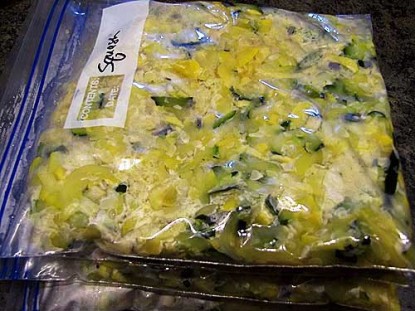Recently, when I wrote about how I blanch and freeze squash and zucchini, I received this comment from Julia:
“Cookery 101 topic request: How do you blanch vegetables? Why would you blanch vegetables?”
I live to serve!
According to the Ball Blue Book of Preserving, “Blanching is a critical step in preparing vegetables for freezing. This is a must for all vegetables to be frozen more than four weeks. However, those vegetables used exclusively for their flavor, such as green onions, hot peppers, and herbs, do not have to be blanched.”
Blanching removes dirt and and microorganisms that can ruin the flavor of food, shrinks the product (smaller packing), and intensifies color.
Before blanching, wash and drain vegetables. Cut them as you plan to use them–dice, chop, slice, etc. Use one gallon of water per pound of vegetables. In some cases, you may want to add produce protector or lemon juice to the water. Bring the water to a boil before adding the vegetables and begin counting the time after placing the vegetables in the boiling water. Blanching time is generally based on size of vegetable or cuts.
After blanching, drain the vegetables and cool before packing. (Cooling by immersing in ice water is best.) After draining and cooling, pack the vegetables as you expect to use them. I usually pack vegetables in two cup batches in quart freezer bags, pressing flat to stack.

Vegetables that should be blanched before freezing include: Artichokes (globe–7 minutes, Jerusalem–3-5 minutes), asparagus (2-3 minutes), lima beans (2-3 minutes), snap beans (3 minutes), beets (till tender), broccoli (3-4 minutes), brussels sprouts (3-5 minutes), carrots (3-5 minutes), cauliflower (3-4 minutes), corn on the cob (6-10 minutes) or whole kernel (5-6 minutes), eggplant (4 minutes), greens (2 minutes), mushrooms (whole–4 minutes, sliced–3 minutes), okra (3-5 minutes), onions (3-7 minutes), parsnips and turnips (3 minutes), peas–blackeye, green, or sugar/snap (1-2 minutes), potatoes (whole–3-5 minutes, french fries–2 minutes), and summer squash and zucchini (sliced or chopped–3 minutes).
Leftover cooked vegetables can always be frozen, too. When we have leftover corn on the cob, I make cream style corn for the freezer simply by cutting the corn off the cob then scraping the “milk” from the cob. The corn has already been cooked in this case, so blanching isn’t necessary.
Just remember when cooking frozen vegetables that have been blanched, you don’t need to cook them as long because they were partially cooked before freezing. You also don’t need to thaw completely before cooking.
I can’t wait to have summer squash and zucchini pizza in January!

Oh, wait, that’s winter……. I can wait……..
Print the handy chart here:
Chart for Blanching Vegetables
Do you have a recipe post or kitchen-related story to share on the Farm Bell blog?
See Farm Bell Blog Submissions for information, the latest blog contributor giveaway, and to submit a post.Want to subscribe to the Farm Bell blog? Go here.



Julia says:
Thanks, Suzanne!
PS: I just figured out I have different user names on Farm Bell and on the main site.
Julia
On July 27, 2011 at 8:48 am
22angel says:
My mom never blanched vegetables before freezing them. Ever. She rinsed the ones that needed it & picked through them if needed, but she always just tossed them in a bag (we had a vacuum sealer of some sort) & froze them. My cousin on the other hand, blanched every. single. thing. To me, after seeing it done both ways, it seems a lot of trouble to blanch them….but that’s just me. We never got sick from not blanching & they cooked just fine. Good info though.
On July 27, 2011 at 1:54 pm
rose weist says:
That is such a great post on the proper method of freezer by blanching…I see all of the advantages…thanx for sharing…
On July 29, 2011 at 8:02 pm